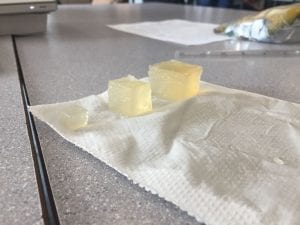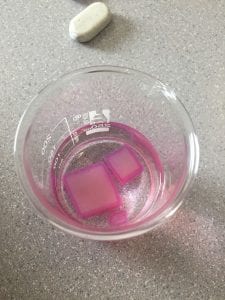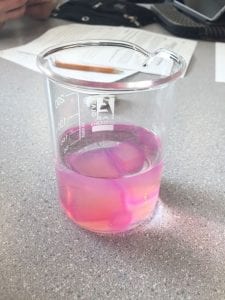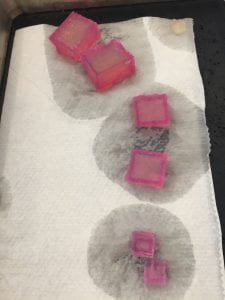Hypothesis: A smaller cell will have a higher diffusion rate because it has less volume and a larger surface area compared to larger cells.
The agar cubes before submerging them in NaOH:
One minute after being in NaOH:
Nine minutes of the cubes being in NaOH:
After 10 minutes:
Our data table:
Conclusion Questions
In terms of maximizing diffusion, what was the most effective size cube that you tested?
We found that the most effective size was the cube with the volume 1 cm3 . The 1 cm3 cube had 75% diffusion whereas the others had 46% and 50% diffusion.
Why was that size most effective at maximizing diffusion? What are the important factors that affect how materials diffuse into cells or tissues?
The smallest size was the most effective because it’s surface area to volume ratio was higher than the other two cubes. Since it had a small volume it was easier to spread throughout the cube. The cubes surface area allowed it to have more space for the diffusion to actually occur. The important factors that affect how materials diffuse are temperature, concentration, surface area, and volume. An area with a lower temperature causes the diffusion to occur at a slower rate. The concentration of the substance used can fluctuate the rate of the reaction as well, a higher concentration increases the reaction rate. As we saw in our lab, the smaller the volume and a larger amount of surface area enhances the diffusion rate.
If a large surface area is helpful to cells, why do cells not grow to be very large?
As a cell grows, the SA:V ratio changes too. In the SA:V ratio, the volume grows at a faster rate compared to surface area. This causes the effectiveness of a cell to decrease as it grows to be larger, which is why cells stay small.
You have three cubes, A, B, and C. They have surface to volume ratios of 3:1, 5:2, and 4:1 respectively. Which of these cubes is going to be the most effective at maximizing diffusion, how do you know this?
The cube that is the most effective out of A, B, and C will be the cube with the 4:1 ratio. This is because it has the highest SA:V ratio, which maximizes diffusion compared to the other two. It has the highest surface area so there is more space for the diffusing material to go through the cube and it also has the smallest volume which means it is easier to diffuse the cube completely.
How does your body adapt surface area-to-volume ratios to help exchange gases?
In the human body, our cells adapt to surface area to-volume ratios by having cells in a long thin shape and/or in an elongated shape. The body also folds the surface of the cell membrane to help exchange gases.
Why can’t certain cells, like bacteria, get to be the size of a small fish?
At first, bacteria have a high diffusion rate because they have a large SA:V ratio. Bacteria then continue to increase in size which decreases the SA:V ratio and also decreases the amount of diffusion that occurs. This causes the cell to divide to regain a high diffusion level, so that it can receive the substances it requires.
What are the advantages of large organisms being multicellular?
Larger organisms being multicellular causes a higher diffusion rate in the body. This is important because cells need certain substances to do their functions like gas exchange and the movement of materials in and out of the circulatory system. Since multicellular organisms have more cells they can also perform more functions.







